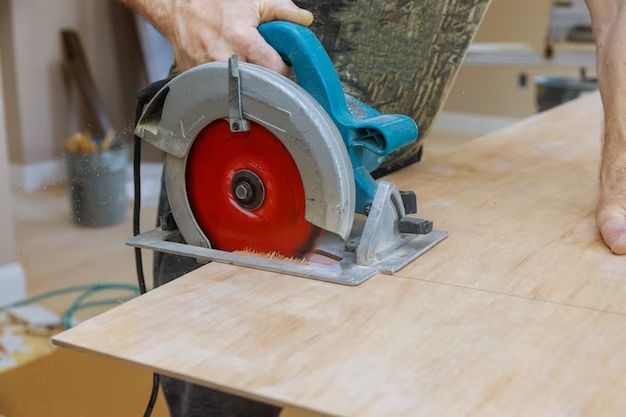When working with plywood, having the right circular saw blade is crucial for making clean and accurate cuts. The blade you choose can make all the difference between a smooth cut and a splintered edge. There are a few important factors to consider when selecting a circular saw blade for cutting plywood.
Page Contents
Blade Type
The most common and best blade type for cutting plywood is a crosscut blade. Crosscut blades have more teeth than rip blades, typically 80 teeth or more. The higher tooth count allows for slower and cleaner cuts through plywood. Since plywood is made up of layers of wood glued together, a crosscut blade minimizes splintering on the top and bottom plies as you cut through each layer.
In contrast, rip blades have fewer large teeth designed for fast cuts along the wood grain. Using a rip blade on plywood will likely cause more splintering. While you can use a rip blade in a pinch, a dedicated crosscut blade is ideal for most plywood applications.
Tooth Geometry
Look for a crosscut blade with carbide teeth with a triple chip grind or an alternation top bevel (ATB) grind. The beveled edges of the teeth slice cleanly through the wood fibers for a splinter-free cut.
A flat top grind blade can also work well for plywood, though not as well as a triple chip grind blade. The flat top also offers a smoother cut than an ATB blade.
Hook Angle
The hook angle of the blade’s teeth impacts cutting performance. For plywood, you generally want a low to moderate hook angle between 5 and 15 degrees. This allows the teeth to slice into the plywood quickly without excess tearing or chipping.
A lower hook angle also reduces potential tear-out on the ply’s backside as the teeth exit the cut. Blades with neutral or zero-degree hook angles (0 degrees) can also work well for ultra-smooth cuts in plywood.
Gullet Size
The size of the gullet, or the space between the teeth, matters for clearing away sawdust. Large gullets allow sawdust to disperse efficiently to prevent burning. Look for a blade with deep gullets of at least 5/32 inches for plywood cuts.
Number of Teeth
As mentioned, a high tooth count is ideal for plywood. Look for a circular saw blade with at least 80 teeth, up to 100 teeth or more. More teeth means each tooth only takes a small bite as the blade cuts through the laminated layers.
This results in minimal splintering and chipping. Lower tooth counts around 60 teeth tend to cause more tear-out issues.
Thin Kerf Blades
Thin kerf blades with thinner plate metal can also work very well for plywood. The thin kerf allows for easy cutting and produces less waste. A standard blade is usually 1/8 inches while a thin kerf may be as little as 3/32 inches. Just watch out for potential blade warping with thinner metal.
Saw Blade Diameter
Most 7-1/4 inch circular saws can handle standard blades diameters between 7-1/4 and 7-1/2 inches. For 10 or 12 inch saws, opt for full 10 or 12 inch blades for maximum depth of cut.
Smaller saws may require reducing the blade diameter to 6-1/2 inches for very tight cuts. The main thing is matching the blade diameter to the specific saw model.
Blade Material
Look for carbide-tipped blades for the best durability and cutting performance in plywood. Carbide holds its edge much better than standard steel over time. Cobalt or titanium coatings can enhance hardness and heat resistance.
Carbide blades typically last up to 10X longer between sharpenings than steel. They cut faster and cleaner as well. While they are more expensive up front, carbide blades save money over time and may even pay for themselves over steel blades on one major project.
Reducing Tear-Out
Even with the optimal plywood cutting blade, chips and splintering can still occur, especially on the underside of the sheet as the blade exits. Here are some tips to minimize tear-out:
- Add a sacrificial backer board underneath the plywood to provide support as the blade exits. This prevents splintering on the plywood’s underside.
- Cut with the good face up to reduce chipping on the visible side.
- Use a sharp blade. Dull teeth cause more splintering.
- Slow down the feed rate for a cleaner cut.
- Cut at shallow depths to reduce backside chipping. Make multiple passes if needed.
- Use a circular saw guide or straightedge for straight cuts.
- Apply blue painter’s tape over the cut line. This can help reduce splintering.
Top Blade Recommendations
Here are some top-rated plywood cutting blades to consider for your circular saw:
| Brand | Model | Size | Teeth | Features |
|---|---|---|---|---|
| Freud LU87R010 | 10″ x 60T Ultimate Plywood & Laminate Blade | 10″ | 60 |
|
| Freud DU87R010 | 10” x 80T Diablo Ultra Finish Saw Blade | 10″ | 80 |
|
| CMT 216.040.11 | 10″ x 80T ITK Plus Blade | 10″ | 80 |
|
| Forrest CM12806 | 10″ x 80T Woodworker II Saw Blade | 10″ | 80 |
|
| Freud LU88R009 | 8-1/2″ x 96T Ultimate Plywood & Laminate Blade | 8.5″ | 96 |
|
Conclusion
Cutting plywood smoothly comes down to using the proper circular saw blade. The best blades for plywood have a high tooth count, carbide teeth with a triple chip or ATB grind, a thin kerf, and a low to moderate hook angle. Top plywood blade models from Freud, CMT, and Forrest feature these specifications. Paired with proper circular saw techniques, a good crosscut plywood blade will provide clean cuts and minimize splintering.
